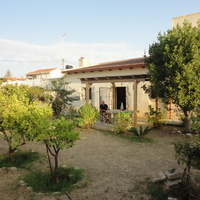Conference Presentations by Aristea Gratsea
Marriage alliances and socio-economic mobility in Venetian Crete (16th century)
LV Study Week: La mobilità sociale nelle società preindustriali: tendenze, cause ed effetti (secc... more LV Study Week: La mobilità sociale nelle società preindustriali: tendenze, cause ed effetti (secc. XIII-XVIII) • Social Mobility in pre-industrial societies: tendencies, causes and effects (13th-18th centuries)
Insular and Maritime Societies in the Mediterranean, Black and Red Seas (15 th-20 th c.) Insular ... more Insular and Maritime Societies in the Mediterranean, Black and Red Seas (15 th-20 th c.) Insular and Maritime Societies in the Mediterranean, Black and Red Seas (15 th-20 th c.)

Interruptions and Disruptions in the Medieval Mediterranean, 400 – 1500 Department of History and Archaeology, University of Crete, Rethymnon 11 – 15 July 2022, 2022
The aim of this paper is to examine the consequences of fall of Constantinople in the shipping an... more The aim of this paper is to examine the consequences of fall of Constantinople in the shipping and trade activities of Venetian Crete. While interruptions in trade and shipping in times of war are to be expected, the study examines the extent of the economic and commercial impact of the fall of Constantinople on Cretan trade and the changes, if any, in the mercantile practice and trade routes. In addition, the focus is on the Cretan individuals who participated in the trade activities with the purpose of assessing if the Ottoman conquest of the city acted as a “turning point” to their activities. The research is based on archival evidence of the Venetian Archives and specifically on Archives of the Duke of Crete (Archivio di Stato di Venezia, Duca di Candia), on the Cretan notaries (Archivio di Stato di Venezia, Notai di Candia) and on the Archives of the Senate (Archivio di Stato di Venezia, Senato Mar).
2019, VI Seminario di Studi Dottorali di Storia ed economia nei Paesi del Mediterraneo - Il notaio nella società nell'Europa mediterranea, 2019
A nord del Mediterraneo. Tradizioni notarili, produzione e uso dei protocolli nell'area trentina ... more A nord del Mediterraneo. Tradizioni notarili, produzione e uso dei protocolli nell'area trentina tra tardo medio evo e prima età moderna
The paper focuses on the transfer of goods during the creation of wills in the last period of the... more The paper focuses on the transfer of goods during the creation of wills in the last period of the Venetian dominion in Crete. It is a case study occasioned by the notarial archives of Zuanne Curini (Sitia, 1560-1670) that are preserved both in the Archivio di Stato di Venezia and the Venetian Archive of Vikelaia Municipal Libraty. It examines the mobilitu of goods in the society of Sitia over a period oun the sense of people who die and those who inherit their goods.
Papers by Aristea Gratsea

Convivium 10.1 (2023): The Architecture of Medieval Port Cities: Italy and the Mediterranean, 100-113, 2023
While the role, architecture, and use of the port of Candia on Crete have been extensively studie... more While the role, architecture, and use of the port of Candia on Crete have been extensively studied, little is known about the island’s other ports
and bays. This article considers key questions to evaluate the role of Fraschia Bay in Venetian Crete’s port system and, by extension, in Venetian shipping activities in the late-fifteenth century and mainly during the sixteenth. What kind of shipping activities were carried out in Fraschia Bay—commercial (legitimate and illegitimate) or/and military? What
types of ships docked there? And under what circumstances was the bay used, especially compared to the port of Candia? The analysis, based on unpublished archival documents of the Archivio di Stato di Venezia, aims
to determine whether the activities carried out in the bay of Fraschia were part of the integrated port system of Candia, or whether Fraschia bay served only as an occasional substitute. The analysis concludes that Fraschia served a complex purpose in Candia’s port system and as a substitute
port at times when Candia was unsuitable, due to weather conditions or construction operations. Moreover, Fraschia Bay’s role went well beyond official mercantile shipping, since it also supported military activities and the movement of contraband

RiMe 9/I n.s. (December 2021). Special Issue. Il Notaio nella società dell'Europa mediterranea (secc. XIV-XIX), a cura di Gemma T. Colesanti - Daniel Piñol - Eleni Sakellariou, 2021
L'oggetto di questo articolo è lo studio dei galeotti e degli andiscari che equipaggi... more L'oggetto di questo articolo è lo studio dei galeotti e degli andiscari che equipaggiava-no le galee veneziane e più specialmente quelle noleggiate nel porto di Candia nel 1570 e 1574. In primo luogo, si fa riferimen-to alle fonti archivistiche che sono usate e soprattutto del notaio Demetrio Baron (1570, 1574). Successivamente, la ricerca si occupa dello stato dei galeotti e si dichiara-no i tre differenti tipi dei rematori che sono impiegati alle galee veneziane e cretesi cioè i contadini, i condannati e gli schiavi. La maggior parte di questa presentazione verte sull’istituzione degli andiscari nella Creta veneziana e il ruolo dei feudatari e dei sopracomiti rispetto a questa istituzione.
[ENG]The aim of this study is to examine the role of the oarsmen and andiscari who manned the galleys in Venetian Crete. In the begin-ning, reference is made to the archival sources that were used and especially of the notarial documents of the notary Deme-trio Baron (1570, 1574). Then, the status of the oarsmen is being examined and a dis-tinction is made between the three different types of rowers who were used in the galleys, i.e. the peasants (contadini), the con-victed (condannati) and the slaves (schiavi).The main part of this article is focused on the institution of the andiscari in Venetian Crete and the role of feudatari (feudal lords) and sopracomiti (commander of a galley) with respect to this institution
Books by Aristea Gratsea

Ψηφίδες Ιστορίας της Πρέβεζας δ΄ / Tesserae of Preveza's History δ΄, 2024
Ο τόμος περιέχει τη βραβευμένη εργασία του τέταρτου διαγωνισμού που προκήρυξαν τα Γενικά Αρχεία τ... more Ο τόμος περιέχει τη βραβευμένη εργασία του τέταρτου διαγωνισμού που προκήρυξαν τα Γενικά Αρχεία του Κράτους - Τμήμα Πρέβεζας και το Ίδρυμα "Ακτία Νικόπολις" για τη συγγραφή μελετών που αφορούν στην ιστορία της Πρέβεζας. Πρόκειται για την εργασία της κ. Αριστέας Στ. Γρατσέα με τίτλο: Η πρώτη βενετική κατάληψη της Πρέβεζας και η συμμετοχή των Ελλήνων. Το χειρόγραφο της Μαρκιανής βιβλιοθήκης. / The volume contains the prize awarded paper submitted in the "History of Preveza Prize Competition 2023", organized by the General Archives of Greece and the Actia Nicopolis Foundation. The paper included in the volume is written by Dr. Aristea St. Gratsea under the title: The first Venetian occupation of Preveza and the participation of Greeks. The manuscript of the Marciana National Library. (In Greek, with English abstract)











Uploads
Conference Presentations by Aristea Gratsea
Papers by Aristea Gratsea
and bays. This article considers key questions to evaluate the role of Fraschia Bay in Venetian Crete’s port system and, by extension, in Venetian shipping activities in the late-fifteenth century and mainly during the sixteenth. What kind of shipping activities were carried out in Fraschia Bay—commercial (legitimate and illegitimate) or/and military? What
types of ships docked there? And under what circumstances was the bay used, especially compared to the port of Candia? The analysis, based on unpublished archival documents of the Archivio di Stato di Venezia, aims
to determine whether the activities carried out in the bay of Fraschia were part of the integrated port system of Candia, or whether Fraschia bay served only as an occasional substitute. The analysis concludes that Fraschia served a complex purpose in Candia’s port system and as a substitute
port at times when Candia was unsuitable, due to weather conditions or construction operations. Moreover, Fraschia Bay’s role went well beyond official mercantile shipping, since it also supported military activities and the movement of contraband
[ENG]The aim of this study is to examine the role of the oarsmen and andiscari who manned the galleys in Venetian Crete. In the begin-ning, reference is made to the archival sources that were used and especially of the notarial documents of the notary Deme-trio Baron (1570, 1574). Then, the status of the oarsmen is being examined and a dis-tinction is made between the three different types of rowers who were used in the galleys, i.e. the peasants (contadini), the con-victed (condannati) and the slaves (schiavi).The main part of this article is focused on the institution of the andiscari in Venetian Crete and the role of feudatari (feudal lords) and sopracomiti (commander of a galley) with respect to this institution
Books by Aristea Gratsea
and bays. This article considers key questions to evaluate the role of Fraschia Bay in Venetian Crete’s port system and, by extension, in Venetian shipping activities in the late-fifteenth century and mainly during the sixteenth. What kind of shipping activities were carried out in Fraschia Bay—commercial (legitimate and illegitimate) or/and military? What
types of ships docked there? And under what circumstances was the bay used, especially compared to the port of Candia? The analysis, based on unpublished archival documents of the Archivio di Stato di Venezia, aims
to determine whether the activities carried out in the bay of Fraschia were part of the integrated port system of Candia, or whether Fraschia bay served only as an occasional substitute. The analysis concludes that Fraschia served a complex purpose in Candia’s port system and as a substitute
port at times when Candia was unsuitable, due to weather conditions or construction operations. Moreover, Fraschia Bay’s role went well beyond official mercantile shipping, since it also supported military activities and the movement of contraband
[ENG]The aim of this study is to examine the role of the oarsmen and andiscari who manned the galleys in Venetian Crete. In the begin-ning, reference is made to the archival sources that were used and especially of the notarial documents of the notary Deme-trio Baron (1570, 1574). Then, the status of the oarsmen is being examined and a dis-tinction is made between the three different types of rowers who were used in the galleys, i.e. the peasants (contadini), the con-victed (condannati) and the slaves (schiavi).The main part of this article is focused on the institution of the andiscari in Venetian Crete and the role of feudatari (feudal lords) and sopracomiti (commander of a galley) with respect to this institution